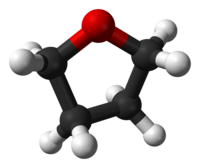
Photo from wikipedia
Bimetallic Ni1−xPdx (0.10≤x≤0.75) alloy nanoparticle catalysts were synthesised and successfully employed for the catalytic aerial oxidation of biomass‐derived furans, such as 2‐furfuraldehyde (furfural), 2‐furfuryl alcohol (furfuryl alcohol), 5‐hydroxymethyl‐2‐furfural (5‐HMF), 5‐methyl‐2‐furfural… Click to show full abstract
Bimetallic Ni1−xPdx (0.10≤x≤0.75) alloy nanoparticle catalysts were synthesised and successfully employed for the catalytic aerial oxidation of biomass‐derived furans, such as 2‐furfuraldehyde (furfural), 2‐furfuryl alcohol (furfuryl alcohol), 5‐hydroxymethyl‐2‐furfural (5‐HMF), 5‐methyl‐2‐furfural (MF) and 5‐methyl‐2‐furfuryl alcohol (MFA), to selectively afford the corresponding furan carboxylic acids (2‐furoic acid, furan‐2,5‐dicarboxylic acid (FDCA) and 5‐methyl‐2‐furoic acid (MFCA)) in water at 80 °C. Among the studied Ni1−xPdx nanoparticle catalysts, Ni0.90Pd0.10 nanoparticle catalyst outperformed the others, achieving high yields of the corresponding furan carboxylic acid products. The presence of Ni in the Ni1−xPdx nanoparticle catalysts was advantageous, because it not only enhanced the catalytic activity for the facile oxidation of biomass‐derived furans using aerial oxygen to achieve high catalytic turnover, but also provided excellent stability to the Ni0.90Pd0.10 nanoparticle catalyst towards air and water and thus significantly enhanced its recyclability (up to 10 catalytic runs). The experiments revealed that the catalytic oxidation of 5‐HMF proceeded by the initial oxidation of the formyl group to carboxylic acid, and, subsequently, the conversion of alcohol to carboxylic acid via the formyl group to form FDCA. Moreover, the one‐pot direct transformation of fructose to furan carboxylic acid products (such as FDCA) was also achieved by using the Ni0.90Pd0.10 nanoparticle catalyst.
Journal Title: ChemCatChem
Year Published: 2017
Link to full text (if available)
Share on Social Media: Sign Up to like & get
recommendations!